Working a Scene and the Decisive Moment — A Practical Guide
I wanted to write a bit more about my process in making street photography, as well some important concepts for not just street photography, but many different styles and genres: “working a scene,” and “the decisive moment.”
I’ve been meaning to get back downtown to shoot more, as it’s been a few weeks since I’ve made any photos in the loop. In sort of a spur of the moment decision, I decided to head down one morning this week, to catch some of the early morning light and the commuters / office workers who’d be heading in.
Because I had a fairly defined goal in mind for the images I wanted to capture, I thought this would be a good opportunity to find and “work” a scene, as I waited for the “right” image to come to me.
What is a “Scene”?
A scene is just any spot you choose to make photographs in for a given amount of time. Basically, I think it’s just any spot that grabs my eye and makes me want to find a good photo rather than something to pass by. This could be due to a confluence of any number of different factors, like nice or interesting light, opportunities for reflections, compositional elements such as foreground elements or opportunities for a frame within a frame, etc. For me, I’m most often looking for hard light, usually in narrow bands as the sunlight slips among the skyscrapers and buildings downtown, or compositional elements like columns, windows, and the like.
A scene is any spot that grabs my eye and makes me want to find a good photo rather than something to pass by.
Early morning light and late evening late are frequently discussed as the cream of the crop, and rightfully so. When the Sun is lower in the sky, you’re more likely to get hard light, resulting in streaks and long shadows. This often makes for dramatic photos, particularly in street photography. I love the warm color of the light during these hours, too. Actually, I feel I struggle to make photos I’m happy with in softer natural light, such as mid-day, or even worse: overcast weather. Something I’d like to push myself on a bit more soon.
What Is “Working a Scene,” and Why Might I Want to Do That?
“Working a scene” is about using your tools and artistic intent to best leverage (or “exploit,” if you will) the scene you’ve found. What sort of photos do you want to make, and what decisions can you make to make the best photos possible at that location? This can be as simple as waiting for the “right” subject to walk through or for things to line up in the way you want, to changing the angle, the lens you’re using, or even influencing the scene depending on your view of the ethics of the situation. (For example, if you walk up quickly causing the pigeons to take flight right as a subject walks past, is that still street photography? What crosses the line? These are all questions you’ll have to think about for yourself.)
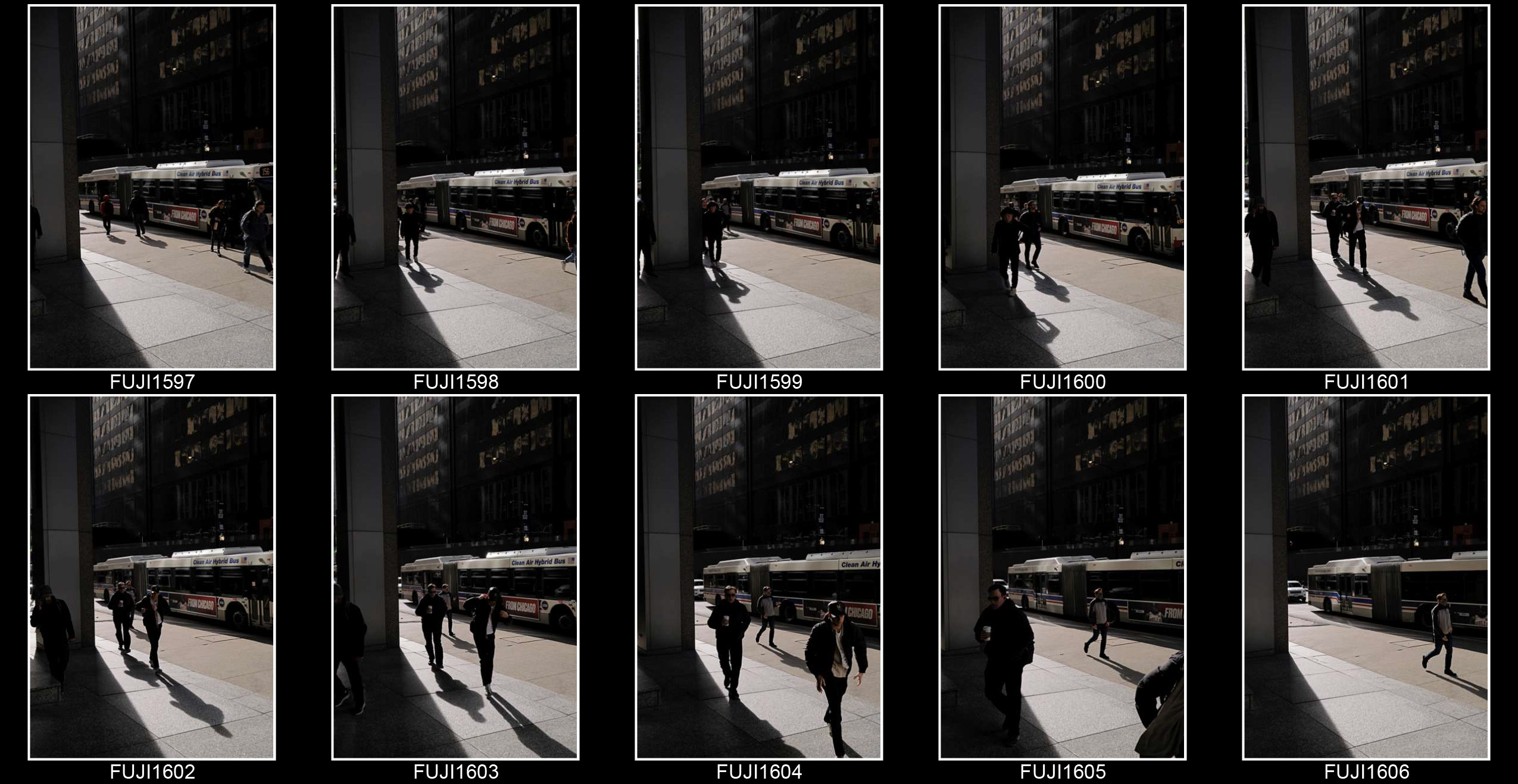
There are a few benefits to this approach. For one, it’s a slower way of working than just walking around and hoping to get lucky. In the heat of the moment, anyone who’s tried to make street photos has probably missed something they wanted to capture, due to unpreparedness, incorrect camera settings, missed focus, etc. Getting set up allows you to make those decisions ahead of time, so you can focus on getting the picture when it presents itself.
It’s also a great way for amateur street photographers to get started. It’s a bit easier to frame up a shot and wait for someone to walk in, than it is to see someone you want to photograph and raise the camera to your face. If you’re less intimidated, you might have an easier time capturing the photos you want to take.
I should say now this is not always my process; I’m just as likely to keep walking at a fast pace, almost never truly stopping, just making loops around Chicago snapping whatever interesting moments I see. It depends on my mood, and on the photos I want to capture. However, I had in my mind the intent to capture people going into work towards the Sun.
So I got off the train in the loop looking for the light. After a bit of walking, I found what I had been looking for.
Contact Sheets
To help illustrate how I take photos, what I’m looking for, and how I’d go about curating and editing these, I’ve gone ahead and made digital contact sheets for all the photos I took at this spot. I’m adding these as JPGs below, and you can download the original PDF just below that. You can make these in Photoshop and a few other programs, but I did this one in Lightroom as I like the way it formats them a bit better. This is not normally something I’d do, instead I’d just load all the RAW photos into Capture One (my editing software of choice) and just cull using the rating system, but I thought it’d help to see all the photos I took sequentially like this. Final caveat: these are completely unedited, JPGs straight out of camera (affectionately called SOOC JPGs among Fujifilm shooters).
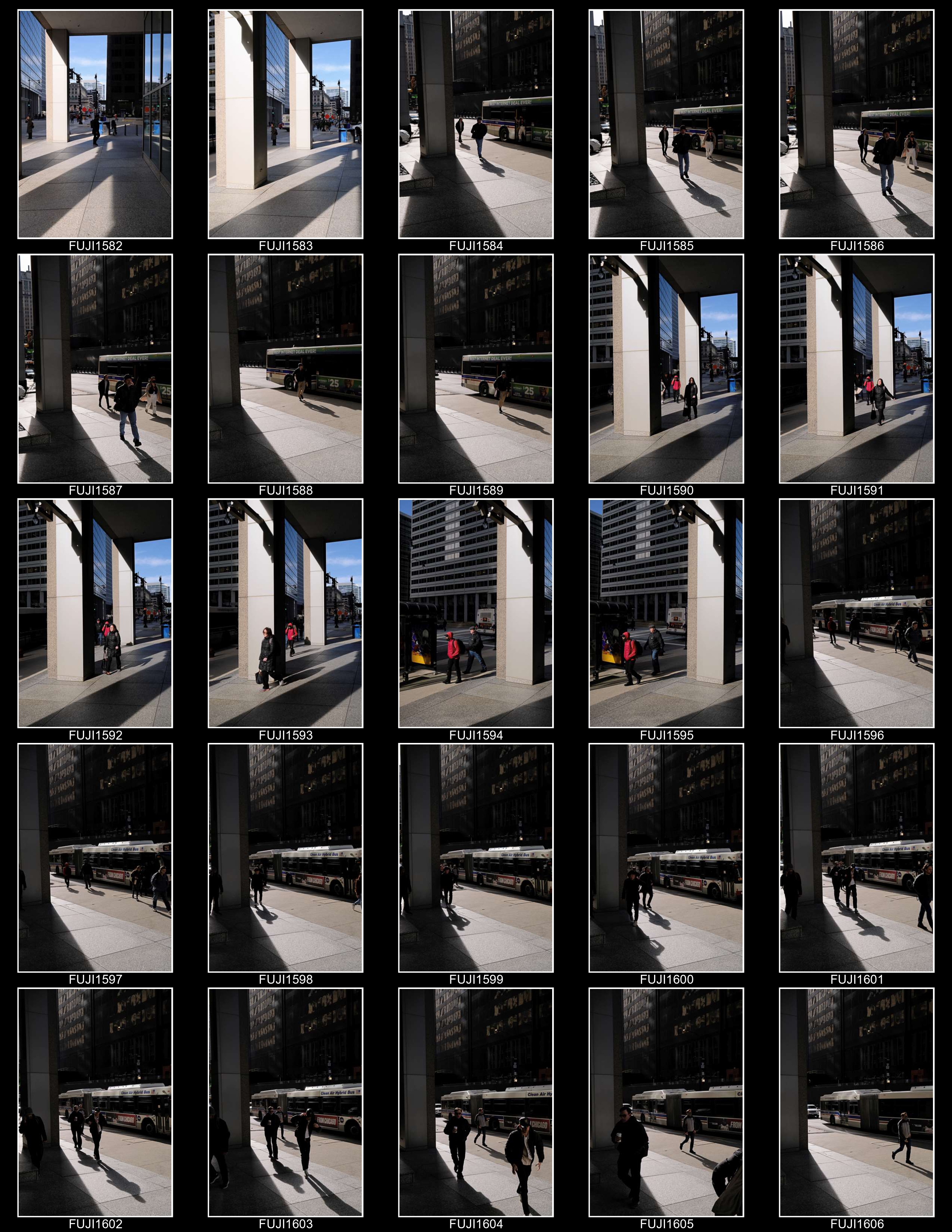
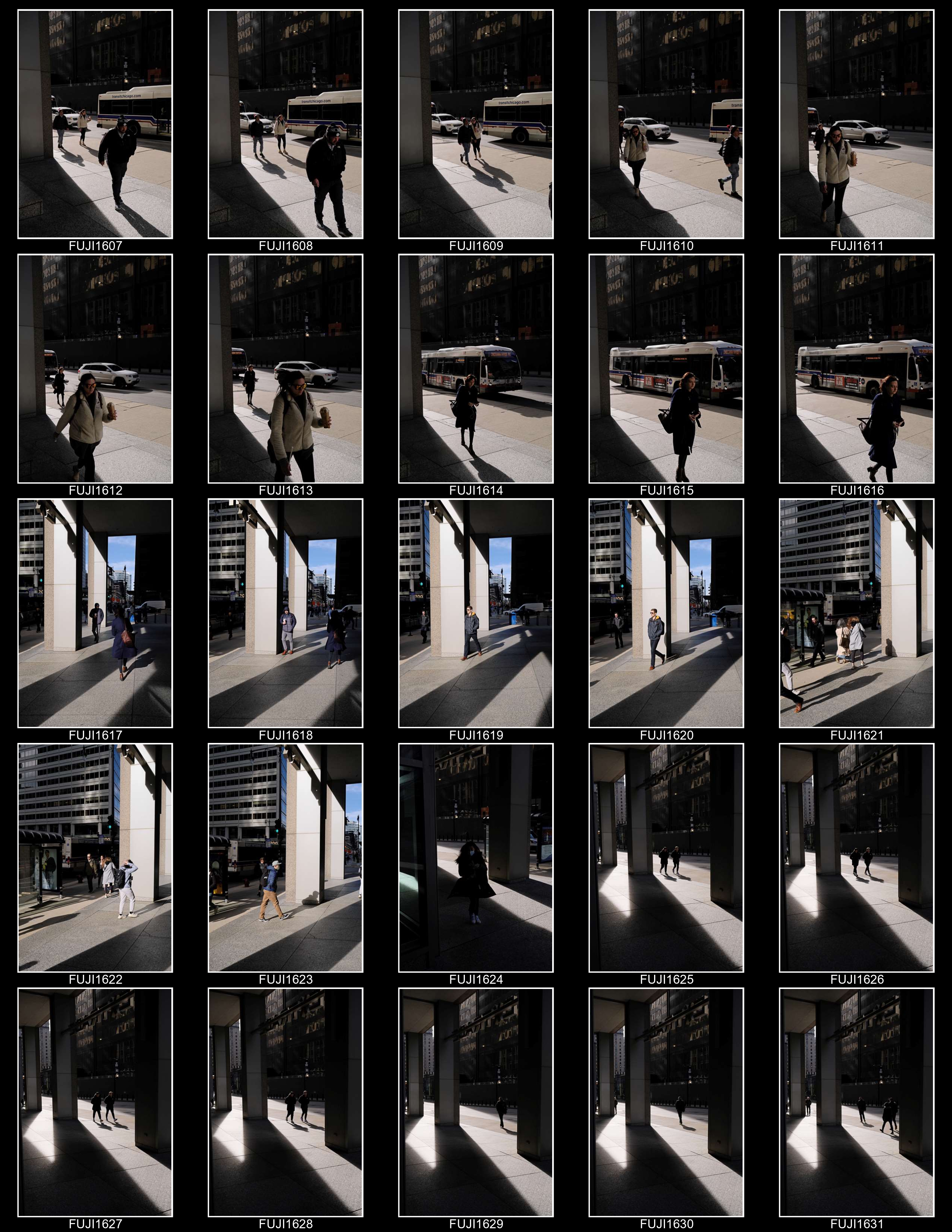
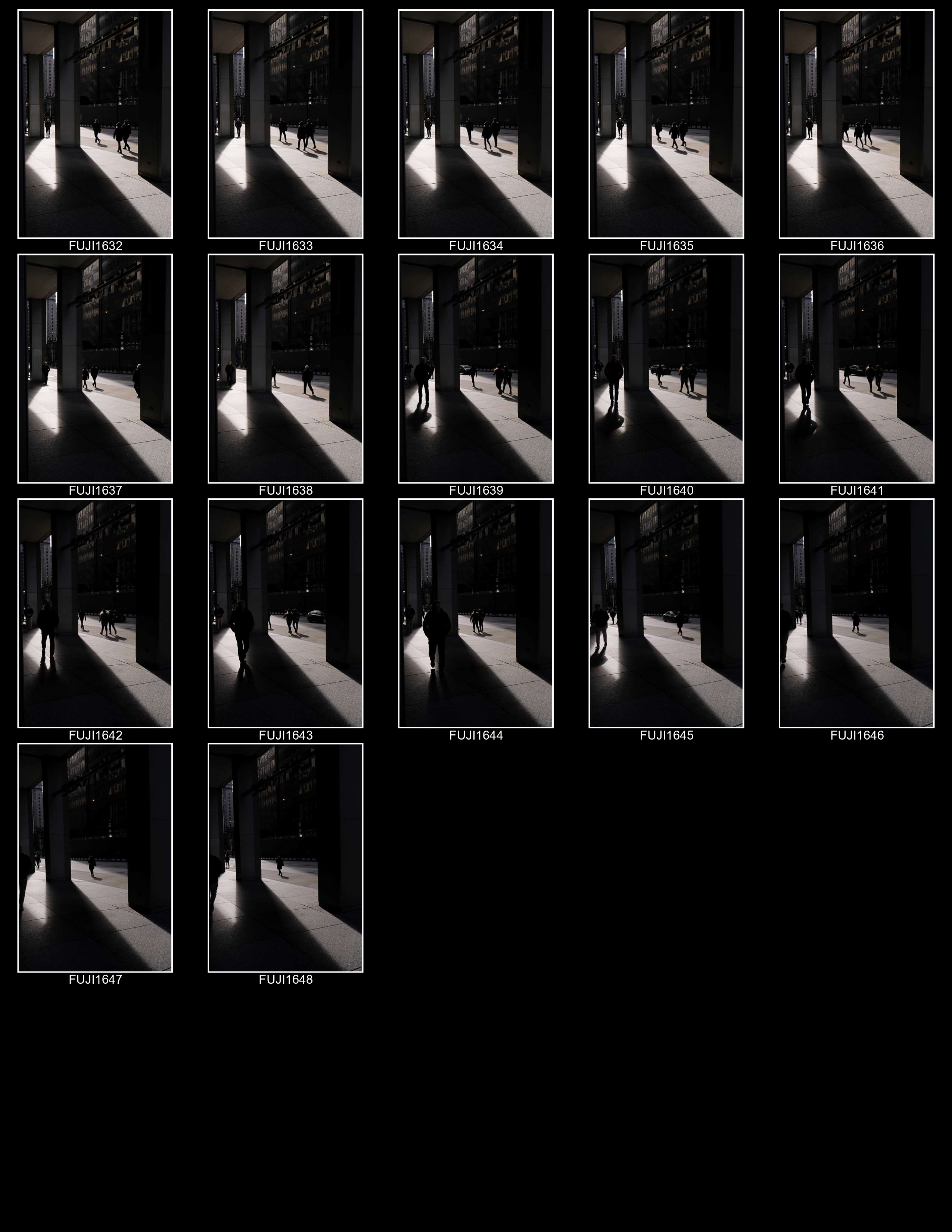
Okay, so from the first three images, the scene should be clear. I’m standing just outside a building downtown with large rectangular columns, which are creating these long shadows and pockets of light. Of course, the light is coming from the Sun, and coming in from East to West (as it does in the morning). You’ll notice I alternate between shooting into the Sun and away from the Sun. My intent had been to capture silhouettes and deeper shadows, which of course means shooting into the Sun, but I switched back and forth based on the presence and direction of the people, i.e., my subjects. Still, the majority of the images are shot towards the Sun.
At this spot that morning, I made 67 photographs, just about two rolls worth. Making a contact sheet invariably makes me think about film. Of course, had I been shooting film, I would not have made nearly as many photos, instead being more decisive about when to press the shutter. But when shooting digital, there’s little reason not to shoot a bit more. Still, I didn’t simply put my camera on high-speed continuous shooting and fire away; I was trying to time out what I wanted in each frame.
First, let’s divide these images into different sequences. I would do this not only by composition but framing; basically, what are the groups of totally unique shots that I should make a select or two from?
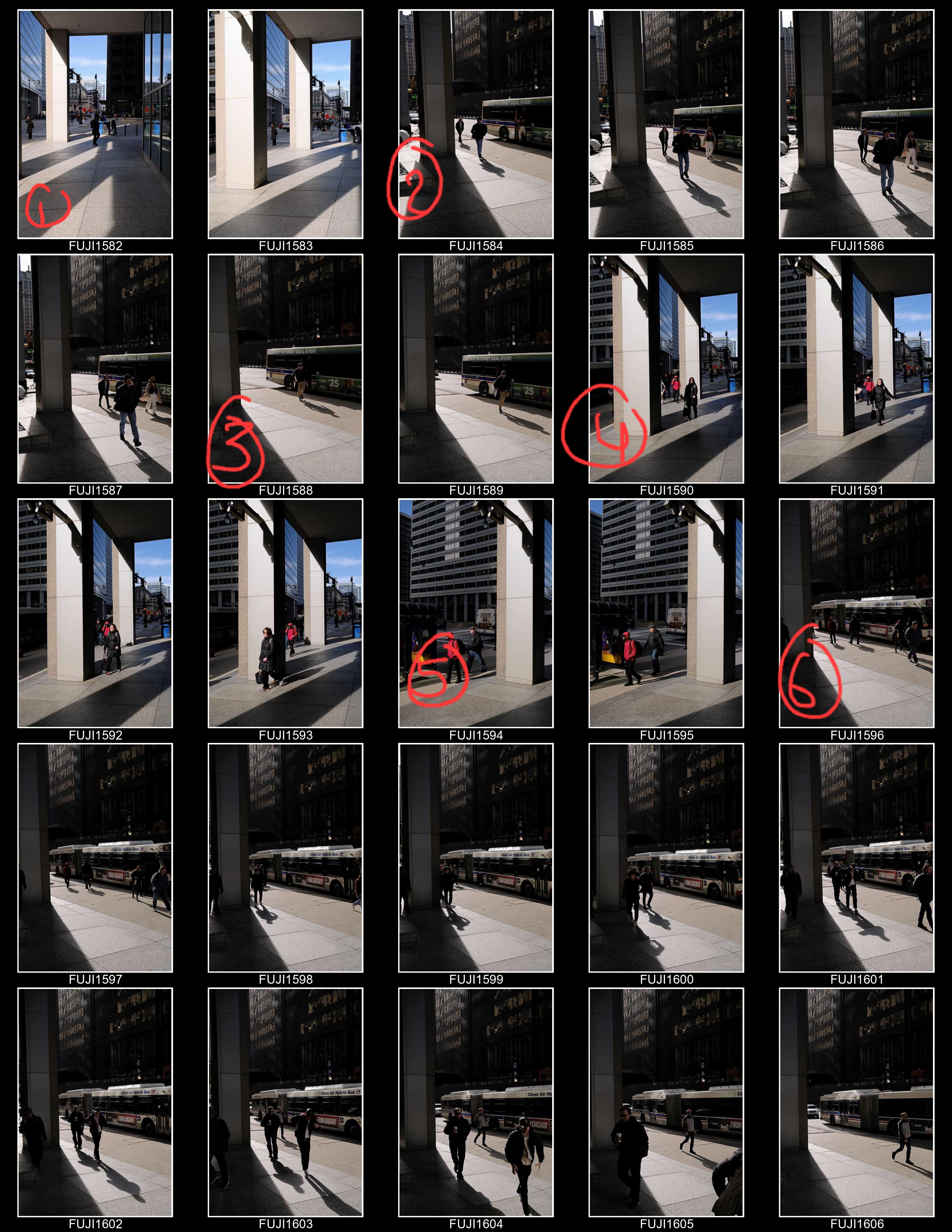
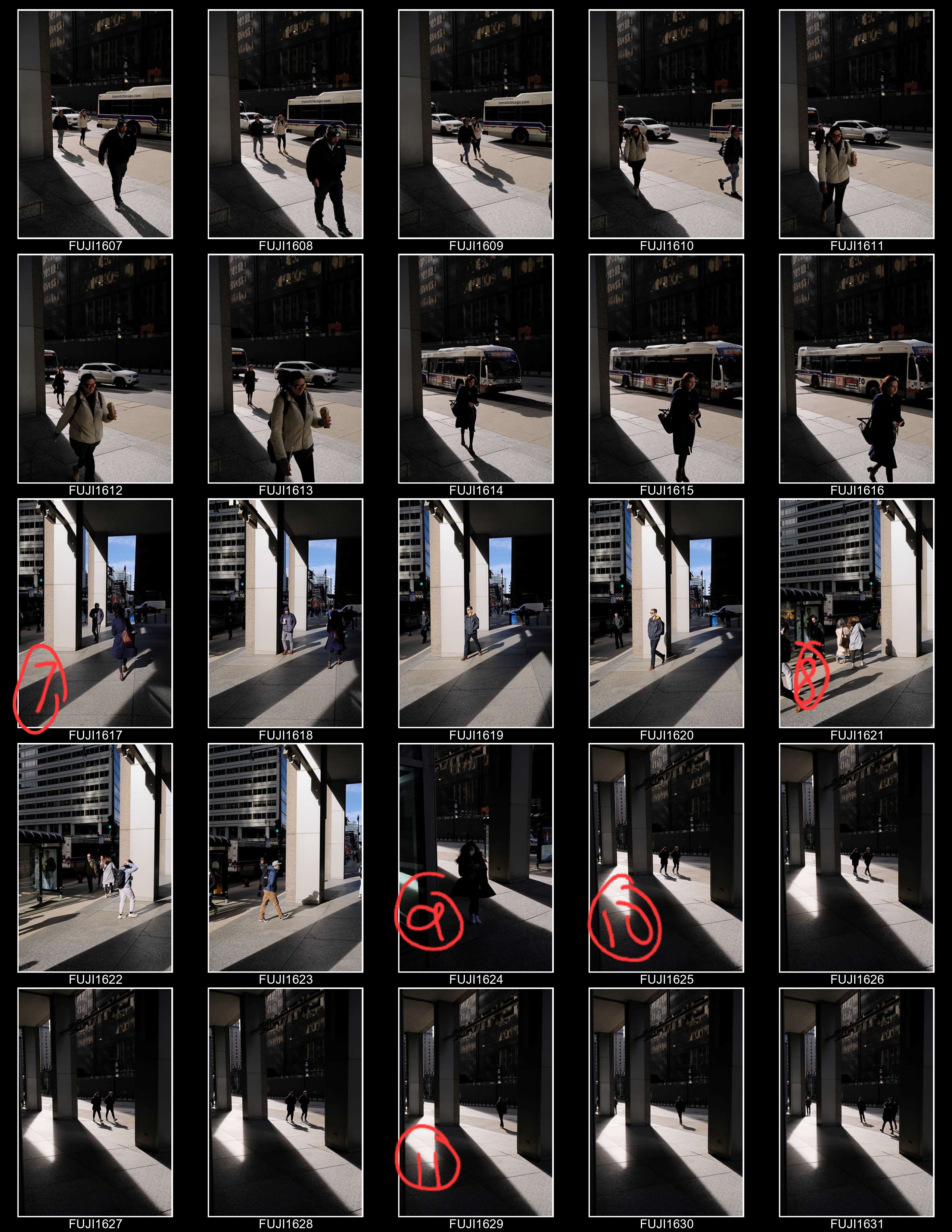
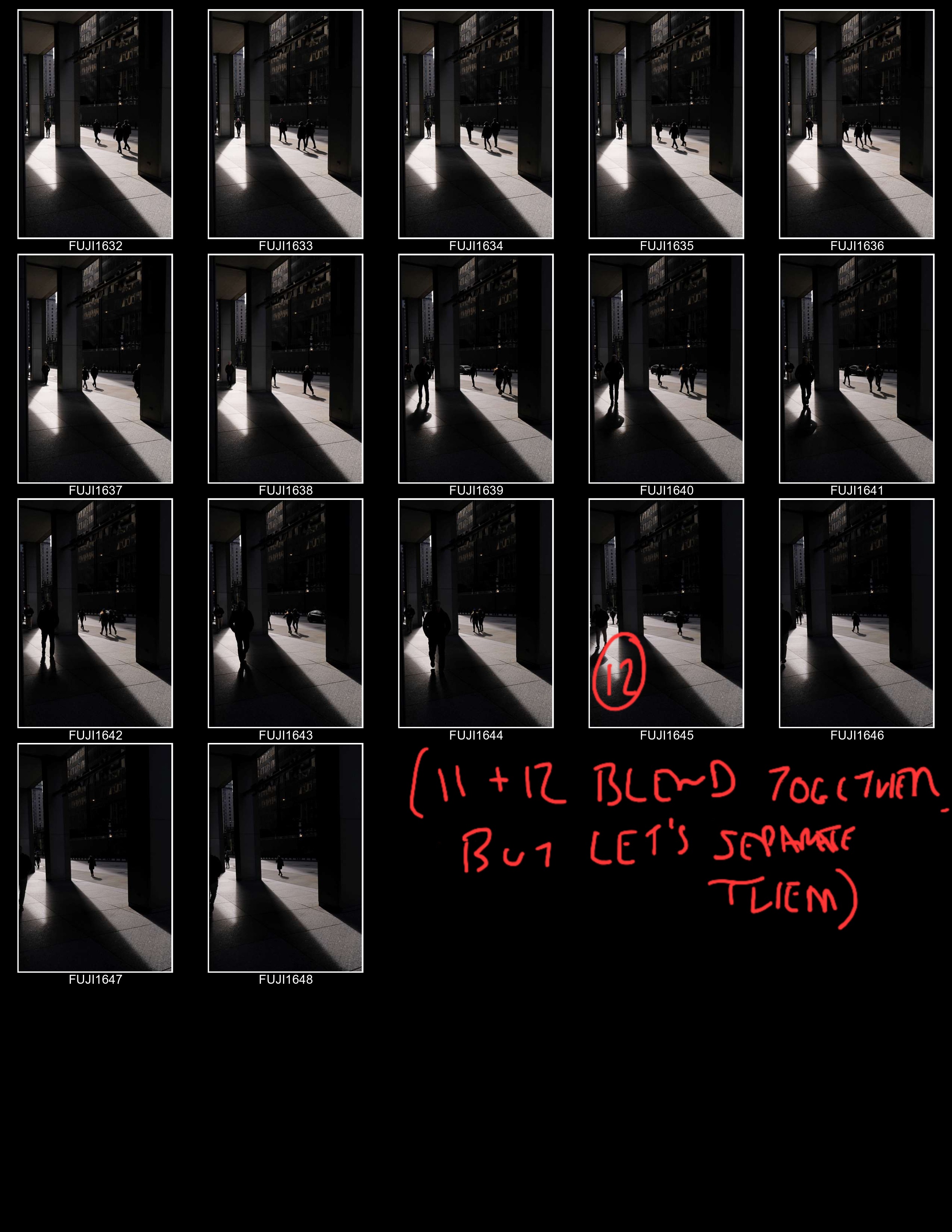
So to my eye, there are 12 different sequences here that make up the 67 images. Right off the bat, I think the shots into the Sun are the most interesting, particularly in sequences six and 10-12, which makes sense as I took the most photos in those positions.
From here, I’ll go through each photo individually, and pick the ones that are my selects to edit the most thoroughly. But what do I look for when making these selects? This is where the “decisive moment” comes in.
The “Decisive Moment”
The concept of the decisive moment comes from the French photographer Henri Cartier-Bresson, one of the most influential photographers of all time, and often considered the father of street photography. Michael Rubin has a fantastic write-up on this at PetaPixel, so I won’t go into too much depth here (I highly recommend giving that a read!). In that article, Rubin discusses how the concept of the “decisive moment” is often misinterpreted, and should focus on composition, but I sort of like the broader definition: the moment that best captures the essence of the scene. Most of the time, it’s the moment that feels the most balanced, or just feels right. Have you ever taken a photo and wished you or the subject was one step over, or it’d been captured a split second earlier? That’s it.
I know this sounds a bit vague, and that’s because it is. It’s about feel. You just know it when you see it, and like developing style, over time you develop a sense for it. Just keep making photos, getting some hits and a lot of misses, and you’ll start to feel what it is you’re looking for.
The decisive moment is the moment that best captures the essence of the scene.
Okay, how about something a bit more practical? Beyond compositional balance, there are a few things I look for in my own work when making selects. Probably first and foremost is stance or posture. Ideally, I want to capture photos of people in full stride. It looks a bit weird to me if someone’s legs are all bunched up. If you were to mimic the stance of the person in your photo, would you fall over? If so, I usually pass on it. I’d like to find some gap between the legs, some stability.
Another thing I look for is eye contact. The eyes truly are the windows to the soul, and most of the time I want a viewer of my work to make an instant connection with my subject, and the best way to do that is with eye contact. How do people look at you as you’re making a photo of them? I rarely want to take a photo of the back of someone’s head, or worse, someone looking at their phone. Of course, this gets harder to avoid all the time, and these photos are a good example of a scene where my intent was to capture people walking away from me.
The last consideration I’ll mention for now is action. This can be easy when you’re thinking about something like capturing a photo of a skateboarder doing a kickflip. When would you want to take the photo? More often than not, I would think that’s at the apex of their jump. But I try to think about this for more subtle things, too. For example, if I want to capture a photo of a woman in a long coat, I try to find the moment when it’s billowing in the way I want. Think about fabric, hair, movement, moment.
Back to Specifics
Let’s close this out with a real-world example from the photos I took. Let’s look at some images from the 10th and 11th sequences, 1625 through 1636.
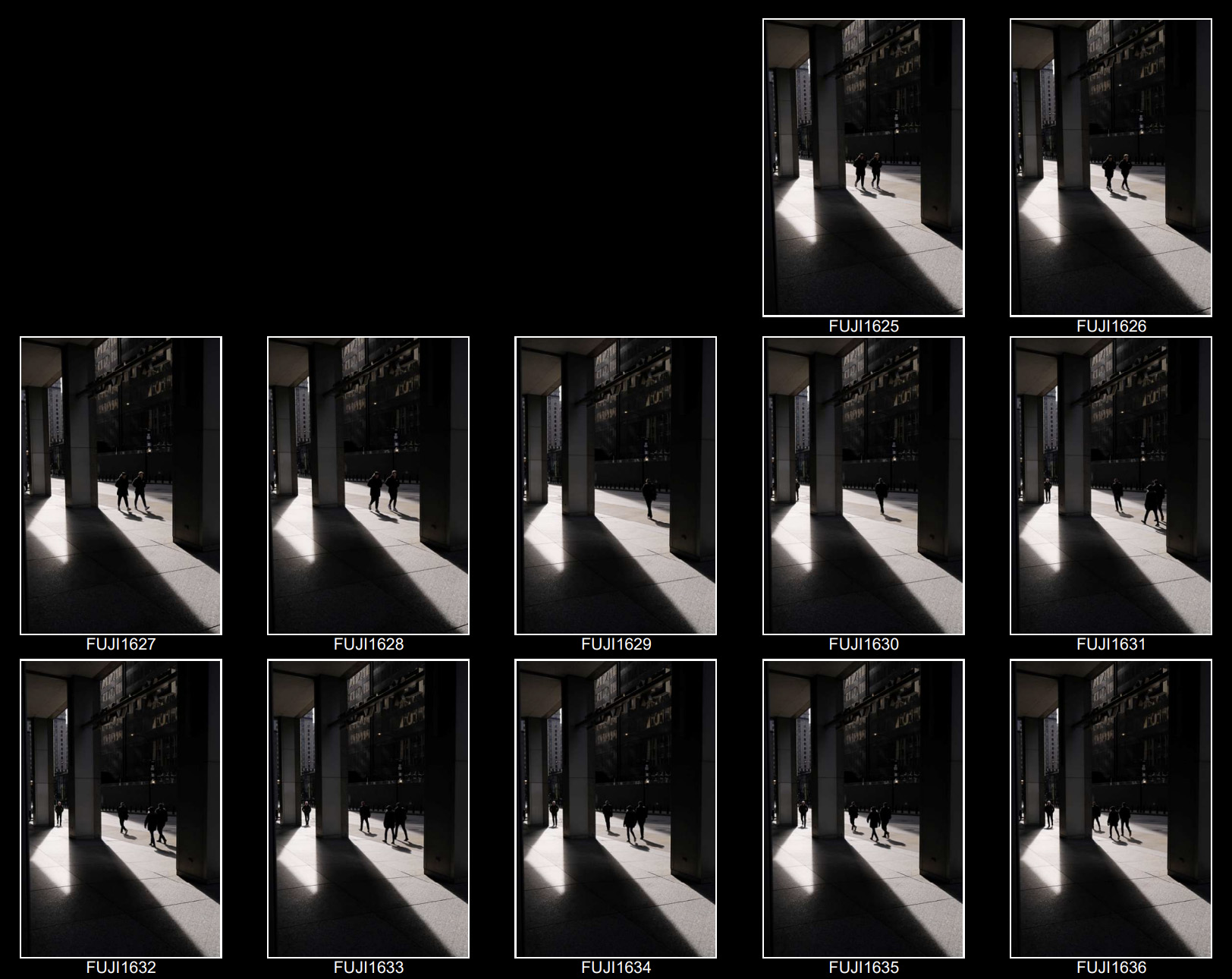
From 1625-1628, which is the best image? You can probably tell I was trying to time my photos to their steps, to varying success. Personally, rather than 1627, I actually like 1626 the best. It’s still full-stride, just with the opposite leg.
How about for images 1629-1636? I like the solo figure, but prefer the last photos I took in this scene for those (1645-1648 on the full contact sheet). The addition of the fourth figure in the other light pool just makes this all the better for me. Here, I think you can make a case for 1632 or 1633—shows you how subjective this is!—but my pick is 1633 here. You get the figures and their shadows well framed by the columns, and in full-stride it really shows the motion of the scene. If I’m really being picky, the figure on the left isn’t in the most dynamic pose, but given that they’re nearly dead-on to camera, I’ll take it.
Final Thoughts
Woof, that was a doozy! But hopefully it gave you not only an interesting look into my process, what I’m thinking about and looking for as I’m conceptualizing an image and during the actual photographing, and how this all relates to street and other genres of photography.
If you liked this post, please consider subscribing to my newsletter, Monochromatic Aberration, at that link or using the button near the bottom of your screen. I write about photograph, writing, and trying to live an examined life. Subscribers get access to some photo wallpapers for your phone, here. Your support means a lot.
